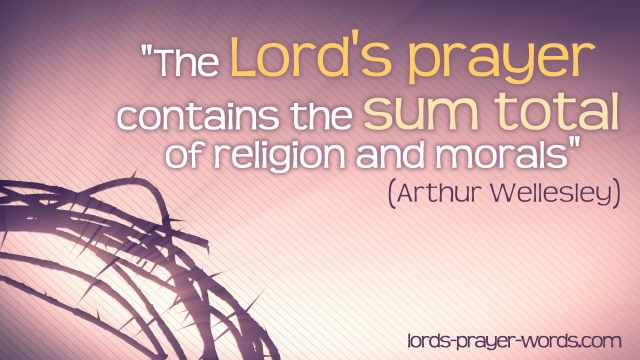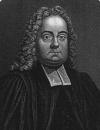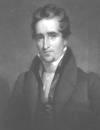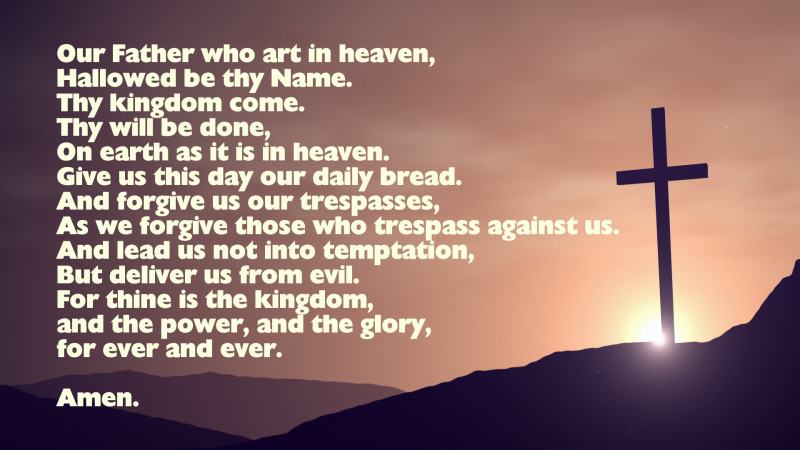Introduction
to the Lord's Prayer
The Lord's Prayer is one of the world's most famous Christian prayers, authored by Christ himself. However, it is worth noting that Jesus was never actually recorded as praying this prayer. He delivered these words as a template on prayer for his disciples:-
This, then, is how you should pray: "Our Father..." etc.,
So in order to pray the way that Jesus taught us, we will need to attend to the meaning behind the words, rather than simply repeating them in a parrot-like fashion. This section of the website explores the different elements of the "Our Father" - , with it's opening adoration of the Lord, followed by it's seven petitions (e.g. forgive us our traspasses etc.), and finally the closing doxology.
resources on this page
Adam Clarke's introduction
Albert Barnes introduction
read more commentaries and studies on the Lord's Prayer in our In-Depth Commentary Section
Albert Barnes
(writing on a summary of Matthew 6:9-13)
Verses 9-13. This passage contains the Lord's prayer, a composition unequalled for comprehensiveness and for beauty. It is supposed that some of these petitions were taken from those in common use among the Jews. Indeed, some of them are still to be found in Jewish writings, but they did not exist in this beautiful combination. This prayer is given as a model. It is designed to express the manner in which we are to pray, evidently not the precise words or petitions which we are to use. The substance of the prayer is recorded by Lk 11:2-4. It, however, varies from the form given in Matthew, showing that he intended not to prescribe this as a form of prayer to be used always, but to express the substance of our petitions, to specify to his disciples what petitions it would be proper to present to God. That he did not intend to prescribe this as a form to be invariably used is farther evident from the fact, that there is no proof that either he or his disciples ever used exactly this form of prayer, but clear evidence that they prayed often in other language. See Mt 26:39-42,44, Lk 22:42, Jn 17:1-26, Acts 1:24.
Source: Barnes' New Testament Notes
Matthew Henry's
introduction to the Lord's Prayer
The Sermon on the Mount.
9 After this manner therefore pray ye: Our Father which art in heaven, Hallowed be thy name. 10 Thy kingdom come. Thy will be done in earth, as it is in heaven. 11 Give us this day our daily bread. 12 And forgive us our debts, as we forgive our debtors. 13 And lead us not into temptation, but deliver us from evil: For thine is the kingdom, and the power, and the glory, for ever. Amen. 14 For if ye forgive men their trespasses, your heavenly Father will also forgive you: 15 But if ye forgive not men their trespasses, neither will your Father forgive your trespasses.
When Christ had condemned what was amiss, he directs to do better; for his are reproofs of instruction. Because we know not what to pray for as we ought, he here helps our infirmities, by putting words into our mouths; after this manner therefore pray ye, Mt 6:9. So many were the corruptions that had crept into this duty of prayer among the Jews, that Christ saw it needful to give a new directory for prayer, to show his disciples what must ordinarily be the matter and method of their prayer, which he gives in words that may very well be used as a form; as the summary or contents of the several particulars of our prayers. Not that we are tied up to the use of this form only, or of this always, as if this were necessary to the consecrating of our other prayers; we are here bid to pray after this manner, with these words, or to this effect. That in Luke differs from this; we do not find it used by the apostles; we are not here taught to pray in the name of Christ, as we are afterward; we are here taught to pray that the kingdom might come which did come when the Spirit was poured out: yet, without doubt, it is very good to use it as a form, and it is a pledge of the communion of saints, it having been used by the church in all ages, at least (says Dr. Whitby) from the third century. It is our Lord's prayer, it is of his composing, of his appointing; it is very compendious, yet very comprehensive, in compassion to our infirmities in praying. The matter is choice and necessary, the method instructive, and the expression very concise. It has much in a little, and it is requisite that we acquaint ourselves with the sense and meaning of it, for it is used acceptably no further than it is used with understanding and without vain repetition.
The Lord's prayer (as indeed every prayer) is a letter sent from earth to heaven. Here is the inscription of the letter, the person to whom it is directed, our Father; the where, in heaven; the contents of it in several errands of request; the close, for thine is the kingdom; the seal, Amen; and if you will, the date too, this day.
Plainly thus: there are three parts of the prayer.
Source: Matthew Henry's Commentary on the Whole Bible Volume V (Matthew to John)

Verse 9. After this manner therefore pray ye] Forms of prayer were frequent among the Jews; and every public teacher gave one to his disciples. Some forms were drawn out to a considerable length, and from these abridgments were made: to the latter sort the following prayer properly belongs, and consequently, besides its own very important use, it is a plan for a more extended devotion. What satisfaction must it be to learn from God himself, with what words, and in what manner, he would have us pray to him, so as not to pray in vain! A king, who draws up the petition which he allows to be presented to himself, has doubtless the fullest determination to grant the request. We do not sufficiently consider the value of this prayer; the respect and attention which it requires; the preference to be given to it; its fulness and perfection: the frequent use we should make of it; and the spirit which we should bring with it. "Lord, teach us how to pray!" is a prayer necessary to prayer; for unless we are divinely instructed in the manner, and influenced by the spirit of true devotion, even the prayer taught us by Jesus Christ may be repeated without profit to our souls.
Source: Adam Clarke's Commentary on the Bible
Next: The first line of the Lord's Prayer
about the commentary writers
In this section you can discover more about the Lord's Prayer through some of the most notable exponents in biblical interpretation.  • Matthew Henry (1662-1714) was a non-conformist English clerygman. His commentaries on the scriptures are intended as a devotional guide to the Bible, rather than as a critical study.
• Matthew Henry (1662-1714) was a non-conformist English clerygman. His commentaries on the scriptures are intended as a devotional guide to the Bible, rather than as a critical study.
 • Albert Barnes (1798-1870) was a Presbyterian minister and American theologian. His 'New Testament Notes' are invaluable in helping to understand difficult passages of scripture. Barnes frequently references the original Greek to reveal the meaning of the text.
• Albert Barnes (1798-1870) was a Presbyterian minister and American theologian. His 'New Testament Notes' are invaluable in helping to understand difficult passages of scripture. Barnes frequently references the original Greek to reveal the meaning of the text.
 • Adam Clarke (1769 or 62 to 1832) was a Methodist minister and biblical theologian. His extensive commentary on the New Testament, at around 6000 pages long, is one of the longest works on the bible ever written by one person.
• Adam Clarke (1769 or 62 to 1832) was a Methodist minister and biblical theologian. His extensive commentary on the New Testament, at around 6000 pages long, is one of the longest works on the bible ever written by one person.

